Peter S
Diamond
- Joined
- May 6, 2002
- Location
- Auckland, New Zealand
Follow along with the video below to see how to install our site as a web app on your home screen.
Note: This feature may not be available in some browsers.
Gear guys always blame the bearingsResult was fatigue failure of the gear teeth.

I would love to hear about precision (with a kinematic error of the order of 1-2-3 arc seconds) gear hobbing machines in 1973 - as far as I know, there were practically no CNC hobbers then."how to compensate for a crappy wormgear" when that hasn't been a problem in fifty years.
Oh, as I already said - this is purely antique interest.Who cares ? (Except for antiquarian interests.)
IT DOESN'T MATTER. YOU DON'T NEED THEM. THEY SERVE NO PURPOSE.I would love to hear about precision (with a kinematic error of the order of 1-2-3 arc seconds) gear hobbing machines in 1973 - as far as I know, there were practically no CNC hobbers then.
I get the impression that the precision worm gears once did something very bad to you.... I'm sorry, I really am.IT DOESN'T MATTER. YOU DON'T NEED THEM.
Actually, that's totally wrong. Unless you are cutting a wormgear of exactly the same size and number of teeth as the wormgear in the hobbing machine, it will do EXACTLY what the mechanism described by Peter S does, except all by itself with no additional mechanism. Tangential feed. Every rotation of the cutting tooth is in a different place relative to the table wormgear.: it is impossible to make a worm wheel for machine X on machine X without losing the accuracy of the machine.
Another half-wit (not you, Asquith. The person who wrote that). The "singing under load is not caused by tooth spacing errors. It is caused by the teeth bending and thus wacking each other as they enter the mesh.'The cause of this singing was explained by Sir Charles A. Parsons in a lecture delivered to the Institution of Naval Architects. Parsons also described an ingenious process, namely the "creep process", for avoiding it. This lecture seems to have been generally overlooked and even firms specializing in the manufacture of gear cutting machines appear to have remained ignorant of it, for only so is it possible to explain why again and again, helical gears cut on machines built by first-class machine-tool makers would sing when on load, sometimes to such an extent as to be quite unusable. .....
Actually, that's totally wrong.
An angle is an angle everywhereAlso, normally, the table wormgear in a hobber, especially one intended for instrument use, will be larger or MUCH larger than the work. For instance, the wormgear in a 6-10 designed for instrument gears is ... I dunno, 12" in diameter ? 14" ? Huge, relative to the max size that the machine will cut (6")
 An error of 100 arcseconds will be an error of 100 arcseconds on both a 20-inch diameter and a 10-inch diameter. Of course, in absolute linear dimensions these will be different numbers.
An error of 100 arcseconds will be an error of 100 arcseconds on both a 20-inch diameter and a 10-inch diameter. Of course, in absolute linear dimensions these will be different numbers.Yes, but the difference won't be that big. How many degrees will the workpiece rotate relative to the worm wheel of the machine? 30 degrees?Tangential feed. Every rotation of the cutting tooth is in a different place relative to the table wormgear.
Yes, damn it, thank heavens - no one NOW uses gears for precise rotation. But, alas, it was not always like this! The key (80-90%) source of kinematic error in a classic hobber is the worm wheel and the worm in the table rotation drive.All of which is moot, because nobody uses gears for this purpose anymore.
Sigh. Theoreticians refuse to accept reality. Here, once again :Everywhere the dependence is approximately the same: the accumulated pitch error of the worm wheel teeth in the machine is approximately 2 times less than the same parameter when cutting a test part on this machine.
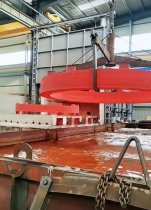
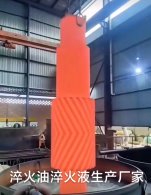
Sigh. Theoreticians refuse to accept reality. Here, once again :
Tell me please, on what kind of grinding machine were the bronze worm wheels from the drive of the tables of gear hobbing machines processed? In addition, maybe I’m wrong - but in the table drive of grinding machines with a worm grinding wheel, a worm gear was installed. Yes, before CNC this was not the most accurate type of grinding machines - but (if I’m not mistaken and worm gears were used to drive the table in these machines) these are still grinding machines with clearly defined accuracy values.Therefore, high load gears are ground after heat treat and the best grinders don't have wormgears or gears of any kind doing the spacing or flank generation.
Of course, I don’t have as much experience in gear machining as you do, but still, 10 years of gear machining does not allow me to be called only a theoretician....Theoreticians refuse to accept reality.
I guess you mean a high pole count rotary not a linear.These days you can get better performance from a linear electromagnet motor.. and a 24 bit absolute position encoder.
sure, i think they are 1940's era russian technology to make up for various failings in other areas.I do think I get the correction gizmos the OP has started with.
yes. but they don't need to be a high pole count. just a very fast, properly compensated control loop. the telescope itself might have a 1 second time constant regarding the maximum torque able to be applied by the motor, so if your control loop runs at 100khz and you have a 24 bit or higher encoder, you can maintain better than 1 arc second positioning, dynamically, before compensating with software to move the mirrors using piezo actuators.I guess you mean a high pole count rotary not a linear.
It's them, right?mathis instruments
Well, many of my colleagues are 70, some are already over 80 - and they are quite capable of designing something more or less modernHow some 70 yr old guy figured out how to do that 30 years ago?

Yes, for Soviet submarines these gears are lapped with abrasive for SEVERAL MONTHS. Everything to reduce noise. But I suspect that now they are still being lapped in assemblies - not a single grinding machine will ensure perfect uniformity of the gears in a pair, in the assembled state.For example.. the reduction gears for submarines were lapped by hand, by specialists who knew how to make the gears quiet down. Those folks are probably all dying off now. This is after the best manufacturers ground those gears..
You see, I am quite ready to believe that these are some unique Soviet developments, in order to somehow do something without having precise machines. But I can’t understand where, for example, Pfauter got the worm gears for his hobberssure, i think they are 1940's era russian technology to make up for various failings in other areas.
just as a leadscrew can be mapped and a cam made to correct for the error, you can do the same for every rotation of the worm screw and gear.
there are many questions remaining as to what was the reason this was done. was it an intellectual exercise to make a better gear cutting machine or was it actually used in production to compensate for worn out gear cutting machines?
 Above, I already wrote about the English UPH30 machine with an electronic correction device, but I could not find its accuracy. So far, all the clues that I have found are the Schiess company, I’m still trying to get their catalog from the 1970s))))))
Above, I already wrote about the English UPH30 machine with an electronic correction device, but I could not find its accuracy. So far, all the clues that I have found are the Schiess company, I’m still trying to get their catalog from the 1970s))))))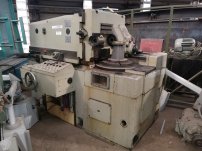
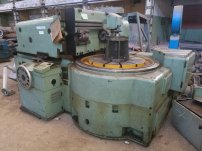
Then the two smaller models received improvements in the form of DROs, etc. Judging by the sales announcement, the number of machines of this type produced was about several hundred (I look at the serial numbers).The maximum accumulated error of the processed wheel metric module M=6 Z=102 D=24 inches is 8µm (6arcsec)!
Now there are no problems with this! As you correctly noted above, direct drive with a high-torque motor to rotate the workpiece and hob + a good high-resolution encoder + calibration = accurate gears quickly, simply, reliably and repeatably.the same technology could be used to produce better master gears.. but as emgo says.. who needs to.
EmGo,Old stuff that serves a purpose and applies to what you can do today is great. I love old stuff that works. But things that are useless, it's like the best way to burn buffalo chips, only interesting as a quaint oddity.
Okay, so I'm going to remove my tentacle from this vortex in the time-space continuum and return to Reality. It's been fun but now time to return from ... the twilight zone.Millingman said:What machines were used to process bronze worm wheels of AGMA 14 accuracy class in the 1950s in the USA?
Sure. Not totally unchanged but almost ... we do physically make stuff better nowEmGo,
Can you give some examples of great old stuff that still applies/works today (I think you mean unchanged)? Genuine question.


 That's now 65 years, can you believe it ?
That's now 65 years, can you believe it ?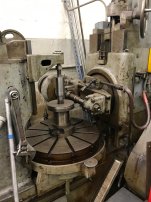

Would I *want* to ? No, I like the Brutalist design ethos. For appearance sake, I like 1950's, 1960's. As I mentioned, have friends who prefer antiques and they are happy using stuff from before our grandpas were born. If kept in good mechanical shape it works fine. (Not talking the space cutters, those are not a great idea and never were). In fact, for some one-off stuff there's machines from the teens or even earlier that would be desirable if you could find one. Just a few years ago I put in a 56" gleason bevel planer in taiwan from I dunno when, the twenties ? thirties ? - I don't think there even are any newer straight bevel machines that big. They built some weird generators that did spirals that would be killer in the single-part repair-replace market.Involute teeth and gear cutting machinery has been around for a long time, but I doubt you would want to use those late 19th century machines.
Engineering development - new challenges met with better ideas.

In some things, probly. But as far as gears go, he was an idjutYour criticism of Charles Parsons is ill-informed, he was a great engineer and with his company, gained the trust of shipping lines, navies, power generators and industries the world over.

Unfortunately, the evidence is opposed to that statement. Your own article mentions that he bought his first set of gears from the Power Plant Company. They worked fine. Then he made a set that didn't work fine. Rather than going to people who knew what they were doing, this nitwit had to go on an ego-driven "inventing" spree where he didn't effing invent anything of value. His ideas have all turned out to be wrong.He (and the other marine turbine manufacturers) would not have developed their own methods of gear cutting if they were already available and suitable.
Notice
This website or its third-party tools process personal data (e.g. browsing data or IP addresses) and use cookies or other identifiers, which are necessary for its functioning and required to achieve the purposes illustrated in the cookie policy. To learn more, please refer to the cookie policy. In case of sale of your personal information, you may opt out by sending us an email via our Contact Us page. To find out more about the categories of personal information collected and the purposes for which such information will be used, please refer to our privacy policy. You accept the use of cookies or other identifiers by closing or dismissing this notice, by scrolling this page, by clicking a link or button or by continuing to browse otherwise.
